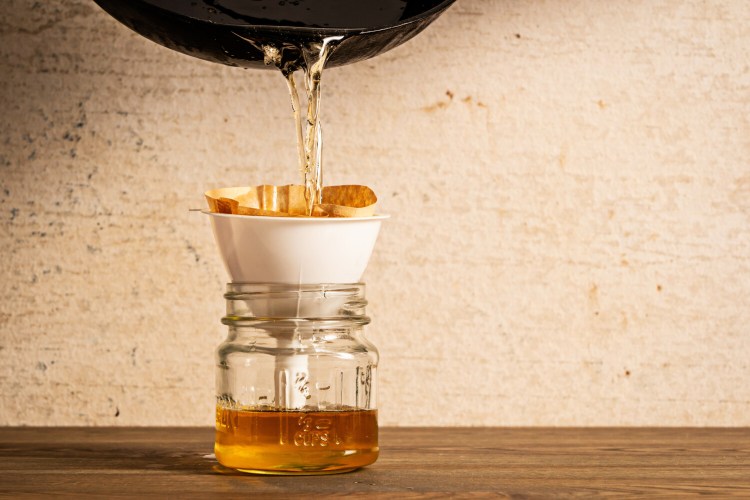I’ve said it before, and I’ll say it again: I love bacon. In addition to the crispy, smoky strips that I serve alongside scrambled eggs or sandwiched in a BLT, a beautiful byproduct is the fat rendered while cooking that can be used to add great bacony flavor to dishes of all sorts.
Many, particularly those with connections to Southern cooking, are hip to the wonders of bacon grease. But for those not in the know or looking to expand beyond their current bacon grease modus operandi, there are numerous ways to put this liquid gold to good use.
It all starts with making bacon (though you could also buy the fat in tubs). The same gentle process you employ to get the crispiest bacon – whether on the stovetop or in the oven – will also render the most fat. At breakfast, I sometimes use it right away to fry hash browns or cook a sunny-side up egg. Other times, when I’m just cooking a couple of strips for myself and there isn’t much fat leftover, I typically sop it up with a paper towel and toss it in the trash can. (You should never pour bacon fat down the drain, as it can cause plumbing issues.) But larger amounts should be saved to prepare meals in the future.
To store bacon fat, pour the still warm (but not hot!) liquid fat into a heatproof container through a fine mesh strainer or coffee filter and place it in the fridge or freezer. (A jar with a wide mouth makes for easy pouring and gives enough room to fit a spoon in for scooping out portions of the solidified fat.) While bacon grease canisters residing on the back of the stove were once commonplace, storing it in an airtight container in the fridge or freezer is recommended to prolong quality.
Straining is important, because bits of bacon left in the fat can cause it to go rancid quicker. “If you don’t filter out the solid bits, the fat can last a couple of months in the refrigerator before it starts to go rancid,” says Simply Recipes. “If you do filter out the solid bits, the fat can last up to a year in the refrigerator. You can also freeze bacon fat if you want to store it even longer.” I typically stick with a mesh strainer, which will still let some small bits through. Use a coffee filter if you want cleaner fat.
So how do you use bacon grease for cooking and baking? Pretty much the same as you would any other fat in your kitchen.
It’s, of course, great for frying. I often use it in combination with a neutral oil, such as canola or vegetable, to fry chicken, because I don’t have enough to just use bacon drippings and want to make sure I have some for other uses. I’ve replaced some of the butter with bacon fat in my baking projects for delicious results. (Can you say peanut butter bacon chocolate chip cookies?) Or you could use it for tasks as simple as making popcorn.
But perhaps my favorite use for bacon grease is with vegetables. Recently, I used it to saute shredded pieces of cabbage for an infusion of umami, or you can melt it and toss it with cauliflower instead of oil before roasting. When added to a pot of simmering collard greens, it lends smokiness to the potlikker, along with velvetiness that you might otherwise get from olive oil or butter. You can even use liquid bacon drippings to make salad dressing.
The possibilities are almost endless, but one word of caution: You should not use bacon fat at too high of a heat, such as to sear a steak, because it can burn, particularly if it wasn’t strained extremely well. It’s best to stick to your standard high-heat fats for such cooking applications. Otherwise, a jar of bacon grease is a great, easy way to add a boost of flavor to just about whatever you’re cooking.
Send questions/comments to the editors.



Success. Please wait for the page to reload. If the page does not reload within 5 seconds, please refresh the page.
Enter your email and password to access comments.
Hi, to comment on stories you must . This profile is in addition to your subscription and website login.
Already have a commenting profile? .
Invalid username/password.
Please check your email to confirm and complete your registration.
Only subscribers are eligible to post comments. Please subscribe or login first for digital access. Here’s why.
Use the form below to reset your password. When you've submitted your account email, we will send an email with a reset code.